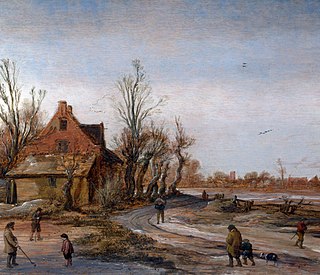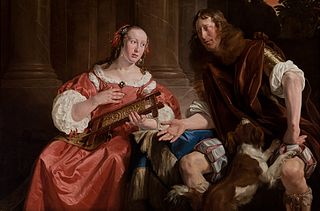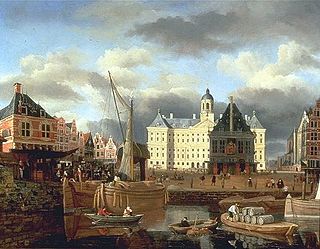
Karel van Mander (I) or Carel van Mander I was a Flemish painter, poet, art historian and art theoretician, who established himself in the Dutch Republic in the latter part of his life. He is mainly remembered as a biographer of Early Netherlandish painters and Northern Renaissance artists in his Schilder-boeck. As an artist and art theoretician he played a significant role in the spread and development of Northern Mannerism in the Dutch Republic.

CasparNetscher was a Dutch portrait and genre painter. He was a master in depicting oriental rugs, silk and brocade and introduced an international style to the Northern Netherlands.

Esaias van de Velde was a Dutch landscape painter.

Jan Lievens was a Dutch Golden Age painter who was associated with his close contemporary Rembrandt, a year older, in the early parts of their careers. They shared a birthplace in Leiden, training with Pieter Lastman in Amsterdam, where they shared a studio for about five years until 1631. Like Rembrandt he painted both portraits and history paintings, but unlike him Lievens' career took him away from Amsterdam to London, Antwerp, The Hague and Berlin.

Jan de Bray was a Dutch Golden Age painter. He lived and worked in Haarlem until the age of 60, when he went bankrupt and moved to Amsterdam.

Willem Kalf was one of the most prominent Dutch still-life painters of the 17th century, the Dutch Golden Age. We first get acquainted with Willem Kalf through Arnold Houbraken, in his Groot Schilderboek, who speaks very highly of him. In fact, Kalf was a highly regarded and celebrated artist during his own lifetime. This was due to his extensive art knowledge and what we gain from Houbraken, his affable personality. His claim to fame now rests mostly on his mature still lifes, pronkstilleven in Dutch, which feature the most exotic and luxurious objects. This can be seen in for example, Still life with nautilus beaker and porcelain lidded bowl from 1662, which became an iconic piece of western art.

Bartholomeus Breenbergh was a Dutch Golden Age painter of Italian and Italianate landscapes, in Rome (1619-1630) and Amsterdam (1630-1657).

Arnold Houbraken was a Dutch painter and writer from Dordrecht, now remembered mainly as a biographer of Dutch Golden Age painters.

Joris van Schooten (1587–1651) was a Dutch Golden Age painter and the uncle of the Leiden mathematician Frans van Schooten.

Abraham van den Tempel was a Dutch Golden Age painter.

Cornelis Brisé was a Dutch Golden Age painter.

Jacob van der Ulft was a Dutch painter, glass painter, print artist, architect and mayor. He was known for his architectural and city views, landscapes and topographical views.

Elias van den Broeck was a Dutch Golden Age flower painter.

Justus van Huysum, also spelled Huijsum, was a Dutch Golden Age painter.

Johannes Glauber, was a Dutch Golden Age painter.
Matthias Jansz. van den Bergh, was a Dutch Golden Age painter.
Gysbert, or Gijsbert Verhoek, was a Dutch Golden Age painter.

Jan van Kessel was a Dutch Golden Age draftsman and landscape painter who made many cityscapes of Amsterdam. His work is often confused with the works of contemporary painters with the same name.

Christiaen Striep, was a Dutch Golden Age painter.
Jan van den Bergh, was a Dutch Golden Age painter.


















